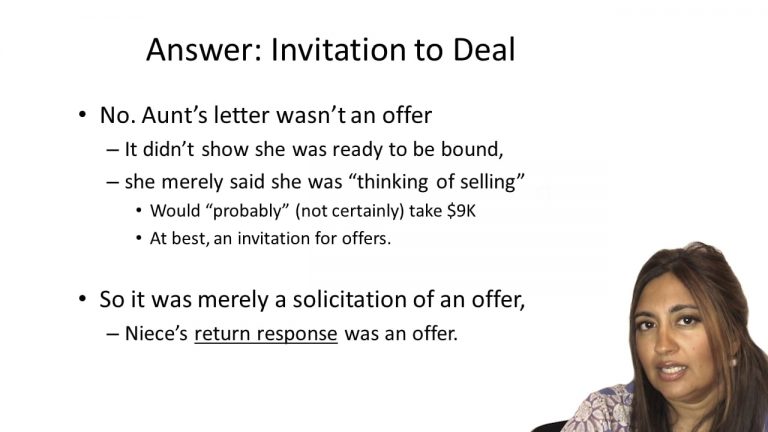SmartBrief
Confirm favorite deletion?
Contracts Keyed to Templin
Lonergan v. Scolnick
Citation:
129 Cal.App. 2d 179 (1954)
ProfessorMelissa A. Hale
CaseCast™ – "What you need to know"
Facts
Scolnick (defendant), who lived in New York, placed an ad in a Los Angeles paper offering property for sale. When Lonergan (plaintiff) responded to the ad, the defendant wrote him a letter on March 26 describing the property, giving directions to the property, and stating his price. The plaintiff wrote back with questions about the location and description of the property, and suggested a bank for escrow should the sale proceed. The defendant wrote back on April 8 confirming the location of the property, providing a legal description of the land, approving the bank for escrow, and stating that the plaintiff would need to act fact because another party was also interested in the property. The defendant sold the property to a third party on April 12. The plaintiff received the defendant’s April 8 letter on April 14, responded the next day stating that he would proceed with the sale. On April 17 he placed his deposit in escrow. Upon learning that the defendant had sold the property to someone else, he sued the defendant seeking specific performance or damages.
Only StudyBuddy Pro offers the complete Case Brief Anatomy*
Access the most important case brief elements for optimal case understanding.
*Case Brief Anatomy includes: Brief Prologue, Complete Case Brief, Brief Epilogue
- The Brief Prologue provides necessary case brief introductory information and includes:
Topic:
Identifies the topic of law and where this case fits within your course outline.Parties:
Identifies the cast of characters involved in the case.Procedural Posture & History:
Shares the case history with how lower courts have ruled on the matter.Case Key Terms, Acts, Doctrines, etc.:
A case specific Legal Term Dictionary.Case Doctrines, Acts, Statutes, Amendments and Treatises:
Identifies and Defines Legal Authority used in this case.
- The Case Brief is the complete case summarized and authored in the traditional Law School I.R.A.C. format. The Pro case brief includes:
Brief Facts:
A Synopsis of the Facts of the case.Rule of Law:
Identifies the Legal Principle the Court used in deciding the case.Facts:
What are the factual circumstances that gave rise to the civil or criminal case? What is the relationship of the Parties that are involved in the case.Issue(s):
Lists the Questions of Law that are raised by the Facts of the case.Holding:
Shares the Court's answer to the legal questions raised in the issue.Concurring / Dissenting Opinions:
Includes valuable concurring or dissenting opinions and their key points.Reasoning and Analysis:
Identifies the chain of argument(s) which led the judges to rule as they did.
- The Brief Prologue closes the case brief with important forward-looking discussion and includes:
Policy:
Identifies the Policy if any that has been established by the case.Court Direction:
Shares where the Court went from here for this case.

 11m 57s
11m 57s